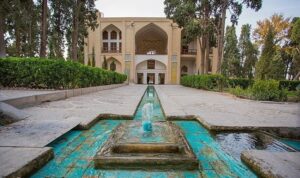Fin Garden of Kashan is a reminder of a bitter historical event: where Amir Kabir was killed. But if we can forget that stinging event for a little while, then the stunning beauty of an enchanting Iranian garden will come into view; A garden in which great art has been used in its construction.
One of the old suburbs of the historic city of Kashan is called Fin, and the garden in it, whose reputation has gone beyond the borders of our country, is known by the same name. Some are of the opinion that the original Fin Garden dates back to the 4th century AD, during the reign of Al-Buyeh dynasty, and it was expanded in the 8th century, during the reign of Moghul tribes. But, the current structure of the garden was undoubtedly formed during the Safavid era and the reign of Shah Abbas the Great. Some consider its designer to be the great Iranian scientist and mathematician Ghiyath al-Din Jamshid Kashani, and others to Sheikh Bahai, a scientist of the Safavid era. However, to better preserve this beautiful garden, Shah Abbas ordered a stone dam to be built, in a short distance from Fin Garden, to protect it from floods. His successors, Shah Safi and Shah Abbas II, were also involved in the expansion and development of Fin Garden. They added a portal to the gateway, a pavilion, and a hot springs bath to the garden.

During the reign of Zandiyeh dynasty, Karim Khan Zand paid special attention to Bagh Fin and built a house which became famous as Karim Khan’s retreat. However, most attention to the garden of Kashan was paid during the reign of Qajar’s Fath-Ali Shah. At his orders, many parts were added to the structures in the garden. In other words, we can say that the present form of Fin Garden was established during the reign of Fath-Ali Shah. He ordered the ruler of Kashan to keep in mind continuous renovation and restoration of the garden and make all efforts in this regard. But, his successor, Mohammad Shah, paid little attention to this garden, and unfortunately since then, the work of maintenance and restoration was forgotten and its buildings not taken care of.
Even during constitutionalism and the events of that time, it became a place for rebellion in the name of Nayeb Hossein Kashi. He and his followers stayed in the garden for fourteen years and caused destruction. But in the period after that, the treatment of the Fin garden was resumed and especially with its preservation and up-keep was ordered by the Ministry of Culture of that time, and the cultural and artistic values of the rare Iranian garden became better known.
Fin Garden is built on 23 hectares of land. In this garden, what is most valuable is the water element, which can be seen in various ways, whether static, flowing, or fountain. The garden reservoir has stagnant water, and in the structures built during the Qajar era, flowing boiling water comes out of the holes in the reservoir. The most pleasant sight is the water running in the streams made with turquoise tiles. The water runs on the sides of the tall and shady trees and creates a pleasant environment that one finds difficult to leave and go. Tubushes or clay pipes, carry water from the pond to the stream and then the water springs out from the fountains. The twelve springs inside the garden pool make water flow in all the turquoise streams and thus creates the most beautiful sight.
Last but not least are the trees in the garden; nearly 580 cypress trees and some sycamore trees, most of which age between 100 and 500 years. Unfortunately, some of them are gone because drought and diseases have been unkind to the trees of Fin Garden. In addition, unprofessional interventions, passing electric wires and cables past them, building lime and cement sidewalks near the trees, improper watering, ignoring the trees’ nutritional instructions, and much other mismanagement have made some trees in garden sick.
It seems that 112 trees from the collection of historical and old trees of Fin Garden have entirely dried up due to neglect (Wikipedia website). Alas!
One of the historical events of this garden is the assassination of Mirza Taqi Amir Kabir, prime minister of Nasser-eddin Shah Qajar, which we mentioned above. He was assassinated on 10th January, 1852. Several other historical events have taken place in this garden, perhaps one of the most important of which was the death of Shah Safi in this garden in 1643 AD. His successor, Shah Abbas II, was crowned in Fin Garden.
Fin Kashan Garden was nationally registered in December 1936 and was included in the UNESCO World Heritage List in 2012.










